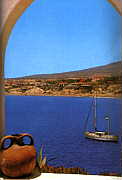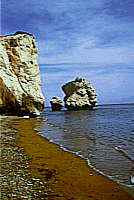|
|
|

The Cyprus The Island Of Aphrodite
 |
Lit
by the burning sun of the Near East, its intriguingly complex culture is
expressed in both landscape and architecture. Cyprus is a land of palm
and pine, hill sides covered in vines, intensively worked plough land,
silent cedar forests and patches of ancient olive and carob groves. The
pleasures of Cyprus come from its apparent simplicity - the straightforward
physical charm of the island and the natural warmth of the people. Of course,
one could not cover the beauties of this renowned Island of Love in a page!
Gods and pilgrims in old times, visitors and tourists of modern times have
been attracted by the incomparable beauties of Cyprus. When people who
come to the island at any time of the year leave, they have the urge to
return to the land with the mild climate, the abundant light and the inexhaustible
natural wonders.
Geography Cyprus is the third largest island in the Mediterranean after Sicily and Sardinia having an area of 9,250 square kilometres (3,570 sq.miles) and a population of 680,000. The coastline of Cyprus is almost 720 kilometres (490 miles). The Northern coast is indented and mostly rocky; in the east and southeast there are sandy long beaches and coves. Troodos mountains in the southwest of the island occupy nearly half of the island's total area. The highest point of the Troodos mountain range is Mount Olympus which reaches a height of 1,950 metres (6,401 ft) and is covered with snow most of the winter months.The capital is Nicosia and is considered as the banking and financial centre. Limassol is the second largest town and is the island's main port and industrial centre. Other main towns in the part of the island are Larnaca and Paphos. Climate The climate is considered as one of the healthiest in the world with hot dry summers and changeable winters with occasional rainfalls and very rare storms. On average, the sun shines for 330 days a year. Average summer temperatures (June to September) range between 20 to 38 degrees Celsius in the central plain and from 15 to 27 degrees Celsius in the Troodos mountains. Winter temperatures range from 5 to 17 degrees Celsius in the central plain and from zero to 9 degrees Celsius in the mountains. The Roads The districts of Cyprus are connected by an efficient network of roads. Many of the older single lane roads have been replaced by new motorways complying with the International Motorways Standards (such motorways connect Nicosia with Larnaca and Limassol as well as Limassol with Larnaca. A similar road connecting Limassol with Paphos is under construction). Roads have been widened during the past 10 years making driving much shorter and more pleasant. Moreover road signs are marked both in Greek and English and make use of internationally accepted symbols. |
 |
|
 |




